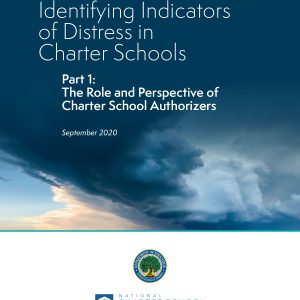Early Warning Systems for Charter School Success: Using Hindsight as Foresight in 2020
Posted on by Aimee Evan

Written by Aimee Evan, Senior Research Associate at WestEd
Early warning systems are used to predict a whole host of things, from financial challenges to climate change. The way an early warning system works is to first look back in order to move forward. By identifying patterns and characteristics from past events that turned out to be risky, you can then use the characteristics in a systemic way to currently identify scenarios of risk and efficiently target interventions. Indicators of distress serve as an early warning system for schools, identifying characteristics that suggest a school may be struggling to provide high-quality education for students.
Drawing from a recent report published by the National Charter School Resource Center, this blog post provides an overview of the concept of indicators of distress, how charter school authorizers can use them, and how using them can divert schools from decline or closure.
What are the warning signs of schools vulnerable to decline or closure?
Using an early warning system can allow charter school authorizers and other stakeholders to identify schools before they enter a stage of decline or failure that is too deep, systemic, or extensive to recover. The following list of indicators is based on authorizers’ observations of schools in decline and the characteristics observed in schools that eventually closed. They provide a good starting point for flagging schools that may need guidance, supports, or simply a more thorough review.
Leadership
- Mismatched leadership competencies to context
- Inability to sustain leadership
- Lack of systemic leadership development
- Lack of leadership
Governance
- Inability to convene the board
- Board’s deteriorating relationship with authorizers
- Board’s inability to hold school leaders accountable
- Inadequate board capacity to govern
Operations
- Breakdown in compliance and reporting functions
- Failure to align to market needs
Finance
- Failure to properly manage finances
- Misappropriation of funds
Talent
- Hiring challenges
- Increased/midyear teacher turnover
- Loss of specialty staff
- Decrease in teacher capacity
Culture
- Poor student/family connection
- Inhospitable professional culture
Instruction
- Lack of focus on instruction
- Lack of cohesion or alignment in curriculum
For example, schools may show signs of larger issues if they experience ongoing leadership or staff turnover, lack of board engagement, or ability to hold leaders accountable. Schools may also be vulnerable if they regularly submit late or inaccurate reports, or if invoices and bills go unpaid.
Using Data to Spot Indicators of Distress
Authorizers often have access to data that allow them to recognize a school in distress at a stage when effective, manageable interventions are possible and the trajectory of hundreds or thousands of students can be improved. The process of identifying schools in distress does not require a vast amount of data or an increase in demands on schools to spend staff time creating reports.
For many authorizers, employing an early warning system based on indicators of distress simply means looking at existing data differently. The authorizers we interviewed didn’t require costly data systems to identify nuanced patterns. Instead, they relied on data already being collected and professional judgment honed by decades of collective experience.
Why indicators of distress help schools succeed
Much of what determines which schools flounder and which overcome challenges is about how schools plan for and address the challenge:
- both the organization’s capacity for learning from and addressing challenges, and
- their access to systems of resources and support when they need additional help.
A charter school authorizer is often the first entity outside the school to realize there may be an issue that needs to be addressed and, by intervening early, stave off a more comprehensive and intensive improvement effort for schools and students.
While interventions and supports vary for different authorizers, all stakeholders benefit from understanding the leading indicators that often precede a school’s decline before decline has affected students’ performance indicators.
- State education agencies can use the indicators to articulate definitions of quality schools, identify supports needed for schools to improve, and evaluate quality authorizing.
- Charter support organizations can use the indicators to determine what and how to address struggling schools, and what support mechanisms are currently working or not.
- Charter management organizations, charter school boards, and the schools themselves can use the indicators to drive improvement.
To further explore this research, view the following NCSRC webinar recordings with charter sector stakeholders.
- The Death Spiral: Identifying Early Indicators of Distress in Charter Schools (A Conversation with Authorizers)
- Risk in Charter School Lending: Indicators of Distress and the Charter School Growth Fund’s Approach to Risk Management
- Indicators of Distress (And What They Mean in the Charter Sector)
Access resources, tools, and support from the National Charter Resource Center.


